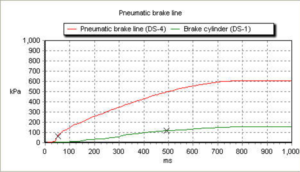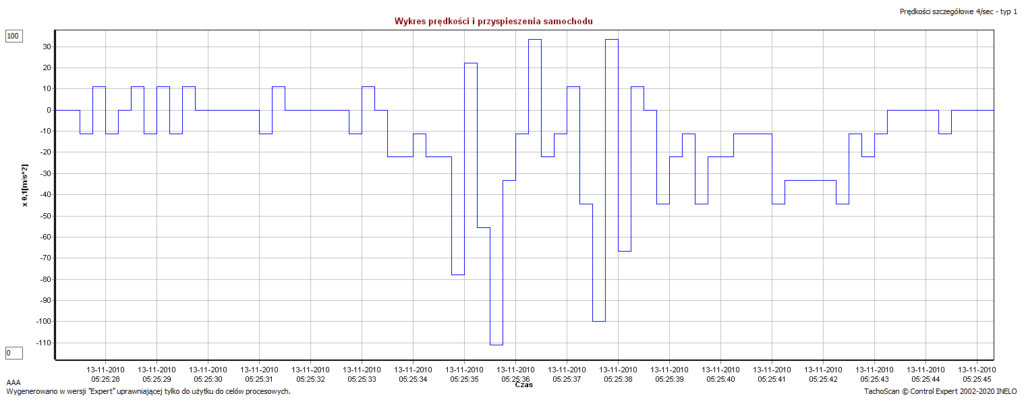A collision between cars and trucks is an event that should be analyzed by the dynamic method using PC Crash software version 14.0. The actual technical condition of the vehicles at the time of the emergence of the emergency cannot be disregarded. The actual efficiency of ABS, ESP, the actual weight of the cargo carried, the actual efficiency of the braking system these data must not be taken as it happens quite often and therefore without basis. In this case, due to the nature of the collision, significant differences in the stiffness of the colliding elements, data from the elek-tronics of the passenger car (EDR, CAN, CAN FD) and data from the truck, semi-trailer, trailer i.e. ODR , CAN data and 4Hz (1/4 sec) data from the digital tachograph or data from the analog tachograph are extremely important. Too often there is no other method to reconstruct a given incident with sufficient accuracy. In this case, visual inspection of the accident scene is extremely important – especially determining the location of the first collision, rather than the subsequent collision between a passenger car and a truck. The place of the first collision can be established by means of measurements by reading this place from the 4Hz digital tachograph recording – by reading from a sketch the place where the truck stopped and transferring this road from the digital tachograph reading, we will get the actual place of the first collision. These determinations can be made even after a considerable period of time. Often, the data on the first crash site is ignored, and another crash site is interpreted as the first one, and often in a different lane. Too often in this type of accident, the location of the first collision is not even looked at. At the site of the first collision are the cars of the Police, Fire Department, etc.. After all, for a specialist, to determine whether the accident in question is the exit of a passenger car into the lane of a truck or vice versa, because the place of the first collision was not viewed by the trial authority is enough to expertly analyze the 4Hz (every 1/4 sec) digital tachograph recording and the data from the sketch and inspection report. The problem is that I have not encountered a case where the opinion makers verified this place, which clearly delineates the factual evidence as the 4Hz digital tachograph recording. As an example of such a case I cite below, where the driver of a truck set accelerated even after the initial collision with a passenger car by moving the passenger car into the opposite lane, even though the collision was in the passenger car’s lane.

Disregarding the reading of data from the ODR or the electronics of the truck, semi-trailer, bus, even having a record of the digital tachograph, it is not possible, without violating the law, to make a reconstruction of a road accident involving a truck, tractor-trailer, bus, because it is not possible, according to the art, to correctly assume the time of accumulation of braking force, as well as the actual value of the transported load, and this is particularly important when the truck is overloaded. The ODR includes, among other things, information on whether the ABS system was technically sound at the time of the emergency, the value of the load on the axles, etc. The reading of the above data is necessary to reliably and factually assume the value of brake force build-up time in the reconstruction carried out, simulating the course of the accident. Especially since differences in the case of unprofessional adoption of the time of accumulation of braking force can provoke different conclusions in the opinion.


Another issue is the impossibility of emergency braking on a straight line by a truck especially a tractor-trailer. A faulty braking system and the lack of emergency braking on a straight line forcing the driver of such a vehicle to brake and accelerate to avoid crossing the team is, in my opinion, often the actual cause of accidents. After all, a faulty ABS system in a tractor-trailer for a simple procedure activates on the dashboard only after a distance of about 100 m, and the Police, ITD, and even an expert checks the lights then in the case of ABS malfunction, the light will not burn when the vehicle before the inspection was not in traffic for a distance of at least 100 m. In Poland, no one checks the correctness of the components of the braking system, and because of this you can use substitutes, which are much cheaper, with impunity. The data of the 4 Hz recording of the digital tachograph indicating to the specialist, that the driver immediately before the collision with another vehicle accelerated, plus the data from the ODR is information that the braking system of the team was already inoperative before the accident and the driver did not have the opportunity to carry out the braking process with full efficiency. In order to determine what specifically was incorrect, it is necessary to determine what components of the braking, suspension system should be on the equipment of the vehicle in question, and what they actually are, and read the ODR, ECU data. An example of such a 4 Hz digital tachograph record below.

Below is part of the ODR data from the WABCO system due to the excessive amount of data I am not giving a full report.


Based on the data from the ODR, with 4Hz of digital tachograph data, the actual movement of the team can be reconstructed using the PC Crash 14.0 program.